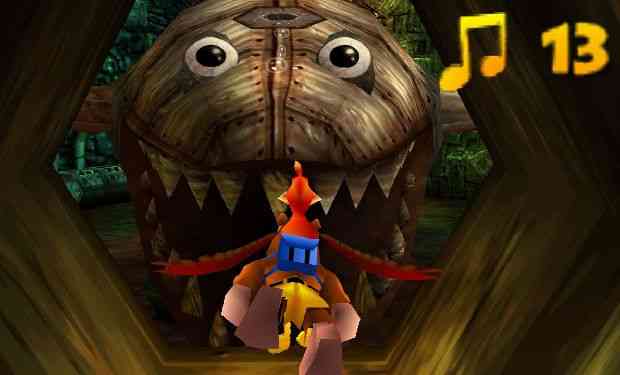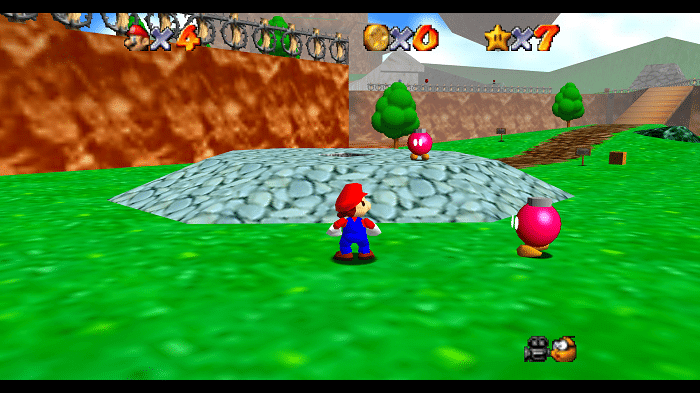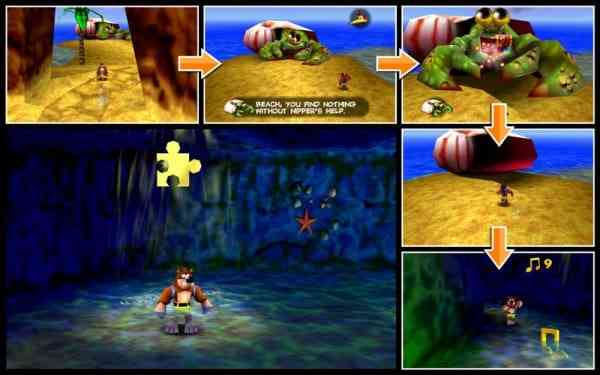Welcome to Part 3 of The Retro Review Series’ fourth episode, covering Banjo-Kazooie. If you’re just joining us now check out parts one and two, ‘The Intro‘ and ‘The History‘ to get caught up.
Banjo-Kazooie was released in June 1998 for the Nintendo 64. It is the story of a cart-racing bear, whose sister Tooty gets kidnapped by a witch named Gruntilda (or “Grunty” as she is often called) because she is upset that Tooty is more beautiful than her. Banjo puts on his backpack, which has an asshole bird living inside of it, reminiscent of the chicken in the bag from The Friendly Giant (remember that show!?) named Kazooie. These two enter Gruntilda’s lair, and make their way to the witch before she can steal all of Tooty’s beauty, and turn her into an ogre. Not a brilliant story, but it serves as well as any Super Mario plot ever has.
Along the way Banjo and Kazooie make several friends… scratch that. Banjo is charming and kind, but Kazooie really antagonizes folks into helping them. Anyways, there’s a mole named Bottles who teaches them new moves (which there are many of), and a witch doctor named Mumbo Jumbo, who transforms Banjo into different creatures in each world. There are lots of characters to meet, and do tasks for/ compete against. Half the fun of meeting them is listening to what their voices sound like. I used to find it strangely amusing to imitate the supporting cast’s voices, usually at my brother.
The game appears to be very cutesy and Disney-like, and does have a very impressive fairytale-like feel, but it has a bizarrely sarcastic and brutal sense of humor. It is 100% silly however, and has some unforgettable dialogue, like a scene where a giant mummy hand taunts “Grabba’s got a jiggy, ner ner ner!” The whole vibe is very unique, and helps to set the game apart from Nintendo’s childlike N64 offerings (looking at you, Kirby and Yoshi). This humor would later successfully appear unbridled in Conker’s Bad Fur Day.
Last month we talked about DuckTales, which is a 2D platformer. In traditional 2D platformers, the player is travelling from left to right, and jumping on platforms. Super Mario 64 was a launch title for the N64 console, and the first great 3D platformer. The original game in the genre set a very high bar, which really still hasn’t been topped; it’s still the gold standard. Banjo-Kazooie heavily follows this formula.
Both games have a massive hub world, which in the case of Banjo-Kazooie, is Gruntilda’s lair. Inside the lair, there are several doors, which lead to different worlds. Worlds are opened by collecting jigsaw puzzle pieces, which are used to complete paintings, which, in turn, make doors to new worlds appear. There are barricades in the lair which can only be passed if Banjo has collected enough musical notes. Each world has 10 jigsaw pieces, 100 musical notes, and various other collectibles to find. The jigsaw pieces are kind of like stars in Super Mario, where they require some kind of task to gather. Musical notes are more like Mario coins, where they are scattered throughout the level, and are collected by exploring. Jigsaw pieces are saved once gathered, but musical notes are saved as a high score if the player dies while collecting them, so OCD players will have to gather them all in one run if they want a perfect score. All the notes aren’t needed to beat the game, but they create a fun extra challenge. As opposed to Mario, the player doesn’t have to enter and re-enter levels to complete challenges, and gather items; every level in Banjo-Kazooie can be fully completed in one run. But like Mario 64, if the player gets enough jigsaw pieces and music notes, they don’t need to complete the worlds in order.
And the level design is so perfect for this! They are large, but not too large, areas that are packed with stuff! One of my biggest complaints of N64 games, is that they were full of flat, bland areas, to create a sense of scope (*cough Mario Kart). Banjo-Kazooie’s levels are dense, and tall. They are full of things to do, and rich in detail. And they are diverse! Level number 1 is a witch doctor’s lush valley, level number 2 is a beach with an incredibly tall rock formation in the middle of it, level 3 is a sewer-like area with a level-sized mechanical shark floating in a lake of muck, level 4 is a poisonous crocodile swamp, level 5 is a Christmas-themed snowy mountaintop, level 6 is an Egyptian desert valley, level 7 is a haunted mansion, level 8 is an industrial dockside, and the final level is a forest with changing seasons. All great, all unique.
The core of Banjo-Kazooie’s gameplay is exploring, and jumping, but there are many abilities to be gathered throughout the journey. There are roll attacks, peck attacks, lunge attacks, double jumps, egg launches, and flying abilities to be gained. Playing and exploring never stops being fun. It will take a good 40-50 hours for a first time completionist to get through the game. I would say it still takes me about 20, and I’ve beaten the game… many, many times.
The game’s graphics are maybe the best on the N64. Banjo-Kazooie definitely pushes the system to its limits. The draw distances are faaaarr! Levels have so much texture that the developers had to develop ways to reshuffle the game’s memory, in order to avoid fragmentation issues.
Grant Kirkhope composed the game’s music, and created a looping score, that changes depending on the mood. It features very catchy, sometimes familiar tunes, which will sound muted if Banjo is underwater, or frantic if he’s in trouble. All of the music is memorable and whimsical, and like the character voices, I used to vocalize these songs often. Check out this awesome game intro for an idea of this soundtrack’s catchy weirdness:
These articles will be released every month on COGconnected, and split up into 4 weekly parts: The Intro, The History, The Review, and The Verdict. So here ends The Review. Tune in next week for The Verdict!



